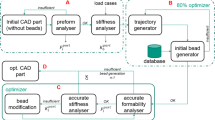Abstract
Recently, during the fabrication of U-bent parts, increasing levels of precision have been required not only for the bend angle of the part but also for the bend radius and the flatness of its bottom surface. The conventional coined-bead technique is therefore unlikely to be applied to achieve these requirements. As an innovative variation of the coined-bead technique, the centered coined-bead technique is proposed and investigated in this study. The finite element method (FEM) was used to clearly identify the parameters of interest based on a stress distribution analysis. The results show that the centered coined-bead formation could be applied to produce a balance between the bending and reversed bending characteristics and to eliminate these characteristics in the bottom surface. Therefore, a precise bend angle and bend radius and a flat bottom surface could be achieved. The effects of the coined-bead geometry and its positioning are also examined and clearly identified, and laboratory experiments were carried out to validate the FEM simulation results. Each U-bent part could be fabricated with a precise bend angle and bend radius and a flat bottom surface using the centered coined-bead technique. The recommended coined-bead geometry and positioning are also reported.
Similar content being viewed by others
References
Lange K (1985) Handbook of metal forming. McGraw-Hill, New York, pp 1–35, 19
Cho JR, Moon SJ, Moon YH, Kang SS (2003) Finite element investigation on spring-back characteristics in sheet metal U-bending process. J Mater Process Technol 141:109–116
Zhang D, Cui Z, Ruan X, Li Y (2007) An analytical model for predicting spring back and side wall curl of sheet after U-bending. Comp Mater Sci 38:707–715
Thipprakmas S, Phanitwong W (2012) Finite element analysis of bending mechanism and spring-back/spring-go feature in various U-bending processes. Steel Res Int: 351–354.
Bakhshi-Jooybari M, Rahmani B, Daeezadeh V, Gorji A (2009) The study of spring-back of CK67 steel sheet in V-die and U-die bending processes. Mater Des 30:2410–2419
Guler MA, Ozer F, Yenice M, Kaya M (2010) Springback prediction of DP600 steels for various material models. Steel Res Int 81:801–804
Jiang HJ, Dai HL (2015) A novel model to predict U-bending spring-back and time-dependent spring-back for a HSLA steel plate. Int J Adv Manuf Technol. doi:10.1007/s00170-015-7274-0
Thipprakmas S, Boochakul U (2015) Comparison of spring-back characteristics in symmetrical and asymmetrical U-bending processes. Int J Precis Eng Manuf 16(7):1441–1446
Marretta L, Lorenzo RD (2010) Influence of material properties variability on spring-back and thinning in sheet stamping processes: a stochastic analysis. Int J Adv Manuf Technol 51:117–134
Tang B, Zhao G, Wang Z (2008) A mixed hardening rule coupled with Hill48’ yielding function to predict the spring-back of sheet U-bending. Int J Mater Form 1:169–175
Seong DY, Jung CG, Yang DY, Ahn J, Na SJ, Chung WJ, Kim JH (2010) Analysis of core shear stress in welded deformable sandwich plates to prevent de-bonding failure during U-bending. J Mater Process Technol 210:1171–1179
Li H, Chen J, Yang J (2013) Experiment and numerical simulation on delamination during the laminated steel sheet forming processes. Int J Adv Manuf Technol 68:641–649
Thipprakmas S (2010) Finite element analysis of punch height effect on V-bending angle. Mater Des 31(3):1593–1598
Thipprakmas S (2011) Finite element analysis on the coined-bead mechanism during the V-bending process. Mater Des 32(10):4909–4917
Phanitwong W, Thipprakmas S (2014) Determination of coined-bead geometry in the V-bending process. Adv Mech Eng: 345152.
Lee JY, Lee JW, Lee MG, Barlat F (2012) An application of homogeneous anisotropic hardening to springback prediction in pre-strained U-draw/bending. Int J Solids Struct 49:3562–3572
Sousa LC, Castro CF, António CAC (2006) Optimal design of V and U bending processes using genetic algorithms. J Mater Process Technol 127:35–41
Author information
Authors and Affiliations
Corresponding author
Rights and permissions
About this article
Cite this article
Phanitwong, W., Thipprakmas, S. Centered coined-bead technique for precise U-bent part fabrication. Int J Adv Manuf Technol 84, 2139–2150 (2016). https://doi.org/10.1007/s00170-015-7858-8
Received:
Accepted:
Published:
Issue Date:
DOI: https://doi.org/10.1007/s00170-015-7858-8




